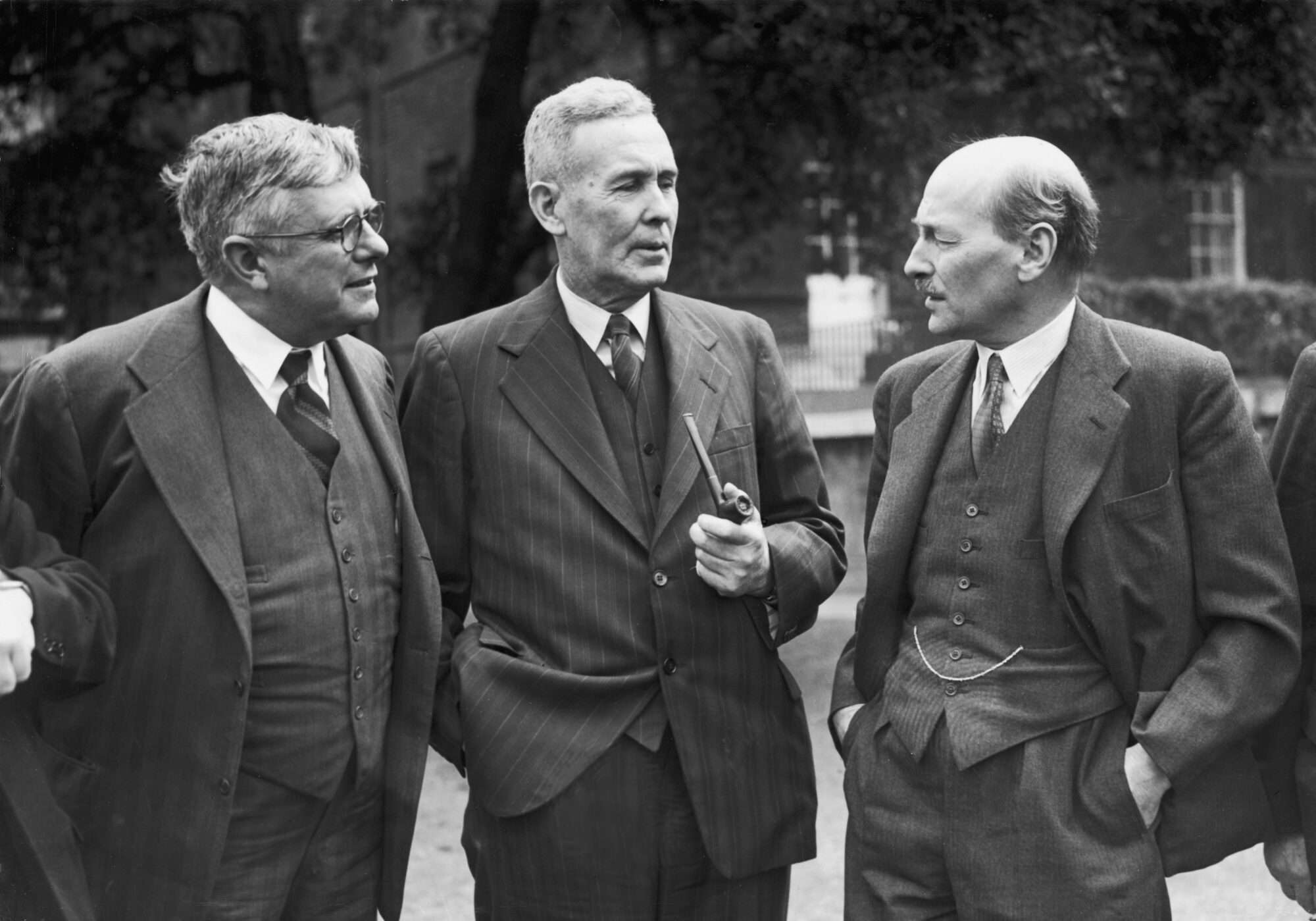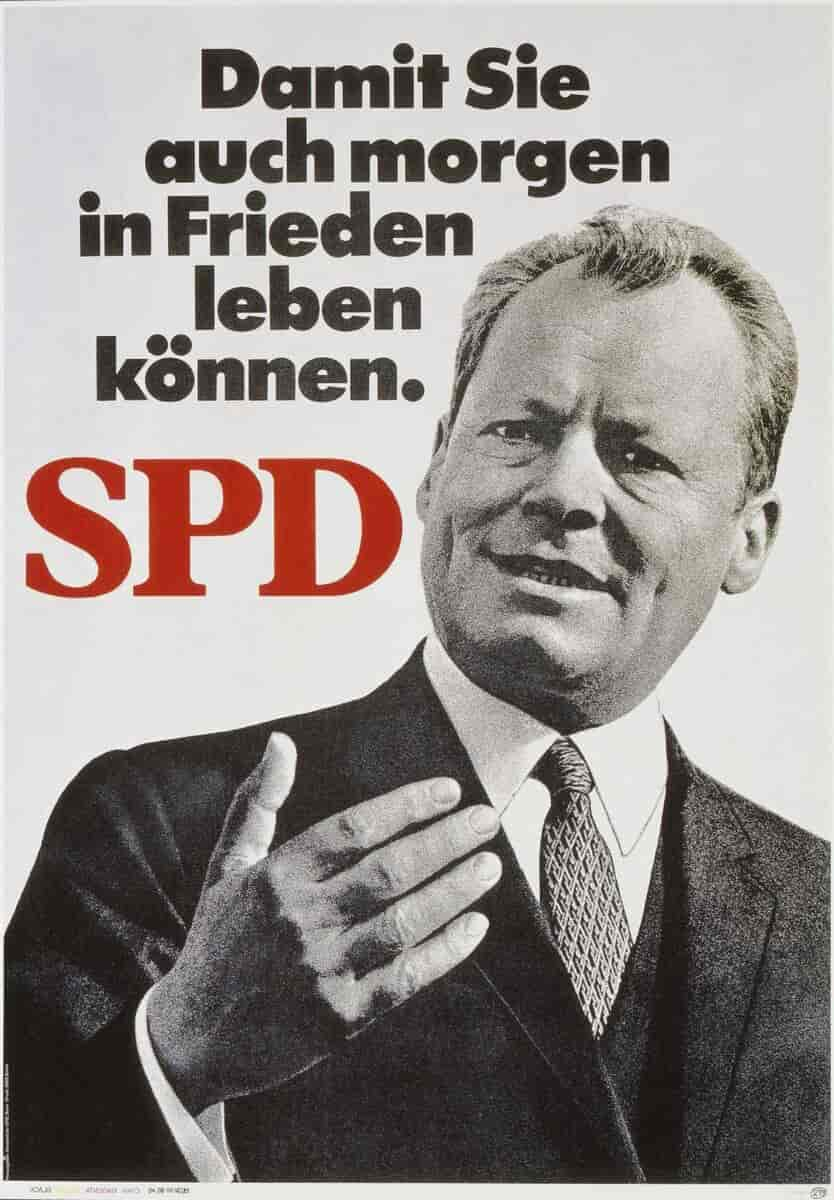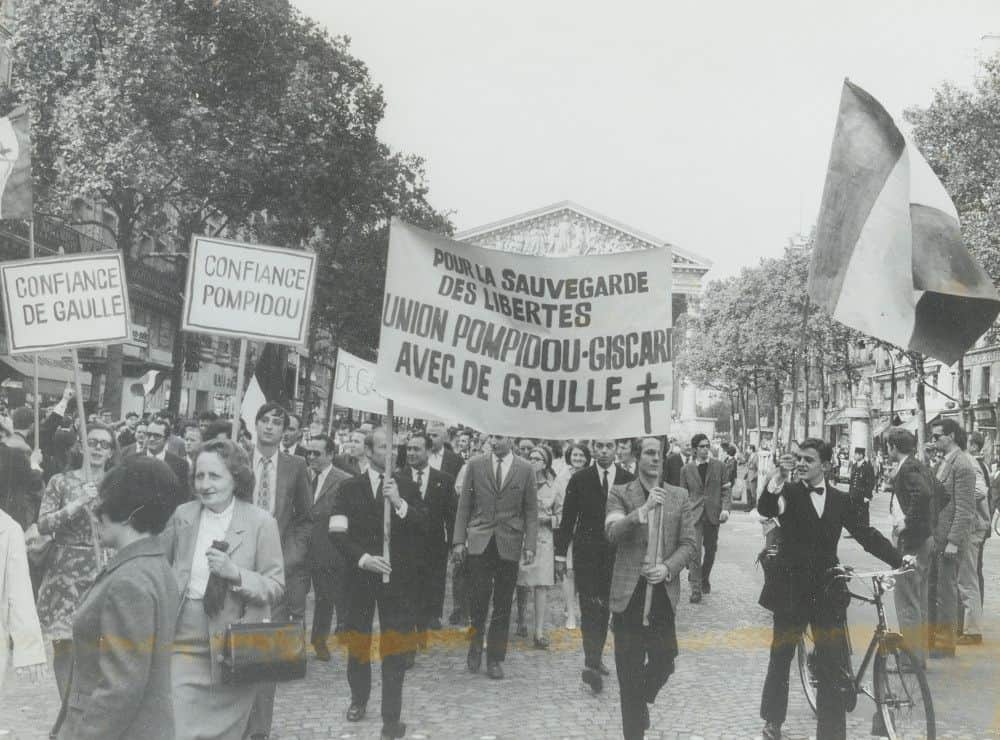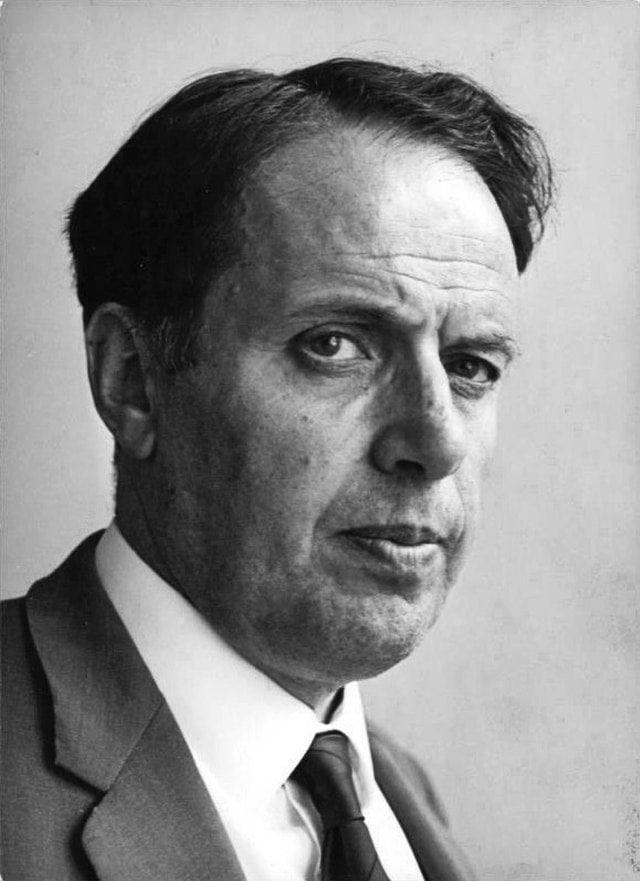This article is part three of a four-part series providing a political history, overview and critical evaluation of the social democratic tradition in Western politics, with some reference to the Canadian experience. This series is a re-publication of the 2017 Discussion Paper entitled ‘Reflections on the Social Democratic Tradition‘ by Andrew Jackson, Broadbent Institute Senior Policy Advisor. Read Part one: What is Social Democracy?, Part two: Social Democracy from the Gilded Age to the Golden Age, and Part four: Contemporary Prospects for Social Democracy
As Sheri Berman has argued in The Primacy of Politics (2006), the post-war years through the 1970s were the Golden Age of social democracy. The general context was one in which the traditional political right and the advocates of free market liberalism had been greatly discredited by the experience of Fascism and the Great Depression, which had also generated a broad popular belief in collectivism and social solidarity. To some degree, the communist alternative weakened dominant class opposition to social democracy, which came to be seen by some as a “third way” between communism and liberal capitalism. (It is important to distinguish this from the “third way” construed by Tony Blair, with the support of U.S. President Bill Clinton and German Chancellor Gerhard Schroeder of the German SPD, as a compromise between traditional social democracy and neoliberalism.)
At the economic level, the Golden Age was marked by very strong economic growth and by close to full employment, resulting in steadily rising real wages and the expansion of the fiscal base needed to finance the growing welfare state. The advanced industrial base built up in the United States during the war was rapidly converted to peacetime purposes, and war-torn Europe was rebuilt through American aid and assistance.
Perhaps the most emblematic political victory was that of Labour in Britain in 1945, which won a large parliamentary majority and ushered in under Clement Attlee the “New Jerusalem” through widespread nationalization of key industries such as coal, steel, electricity, gas, the railways and long-distance trucking and transport (but not finance, except for the Bank of England) and the birth of the cradle to grave welfare state. The blueprint was set out in the Beveridge report, which emphasized economic and social security for all as well as a concerted fight against poverty.

Labour introduced significant social programs such as universal child allowances, much more generous and nonstigmatizing unemployment and welfare benefits, decent old age pensions, huge investments in public education and public housing and, above all, the creation of the National Health Service, which provided publicly financed and publicly delivered healthcare. The great majority of at least manual and semiskilled workers enjoyed workplace rights through strong unions and the benefits of collective wage bargaining. Nationalization was seen as a way to redistribute wealth and as a tool for industrial modernization, but British Labour did not introduce centralized economic planning on the French model or experiment with workplace democracy in the public sector or private industry.
The Attlee government can be seen in retrospect as probably the peak moment of social democratic advance, overseeing not just the emergence of the welfare state but also a major increase in the economic role of the state as a guarantor of full employment, widespread collective bargaining and high levels of public investment. But Labour lost its majority in 1951 and the Conservatives ruled until 1964. The fact that unions and socialist parties were often illegal until late in the century underlined the notion that moving beyond capitalism would involve a fundamental political rupture, though Marx himself recognized that a longer term transition through democratic institutions might be possible in a country like Britain. For their part, the traditional governing classes and capitalists often resisted political democracy out of fear that it would unleash and empower social forces that would destroy private property.
As mentioned, the French Socialists were electorally much weaker than the Communist Party until the late 1970s and came to executive power only in 1981 as part of a popular front coalition with the Communist Party (though the Socialists had an independent parliamentary majority until 1984). President Francois Mitterand was in office from 1981 to 1995, but only the first three years of his term were ones of major left advance. In retrospect this experience, coming at the start of the neoliberal era, can be seen as the last major attempt in non-Nordic Europe to move decisively towards democratic socialism.
The common program of the left, which was more or less fully implemented, included a sweeping nationalization program, extending to major banks and insurance companies and some industrial giants, intended to maintain traditional national control of the commanding heights of the French economy in an age of multinational corporations. There were major social and political reforms, including attempts to decentralize the highly centralized French state to the local level, and labour reforms, including reduction of working time and a significant expansion of trade union rights that required employers to bargain collectively and, in a gesture to workplace democracy or “autogestion,” extended the role of workers councils at the enterprise level. The minimum wage, pensions and social benefits were hiked in a major attempt to deal with
rising unemployment through a redistributive Keynesian stimulus. The change of course to fiscal austerity in the mid-1980s has been widely seen as proof of the limits of Keynesianism in an emerging globalized economy, though other progressive economists note that the program would have been more successful if the Franc had been devalued and if France had not been obliged to reflate alone. In any case, France did not move in a pronounced neoliberal direction until well into the 1990s, and grew at a fairly healthy rate.
In Italy, the democratic left was also much weaker than the Communist Party until the latter itself became, essentially, social democratic in the 1990s, and was generally a junior partner in centrist coalitions.
In Germany, the SPD led the government under Willy Brandt and then Helmut Schmidt from 1969 to 1982, but the major differences with its frequent coalition partner, the Christian Democrats, were over foreign policy issues rather than the basic lines of what was dubbed the “social market economy.” This included generous social insurance programs, statutory works councils to represent employees in the workplace and widespread collective bargaining to determine wages. Again, this model was not fundamentally challenged until well into the 1990s.
To summarize, the experience of sustained strong social democratic government even in the Golden Age was mainly confined to smaller European countries such as Sweden, Norway and the Netherlands, and social democrats were far from politically hegemonic in the post-war years.

A muted form of social democracy emerged in Canada at the end of the war as the Liberals, under strong political pressure from the ascendant CCF, supported labour rights, resulting in a major expansion of the union movement to include some 40 per cent of the labour force, and expanded public pensions and unemployment insurance. However, much of the modern welfare state did not become a reality in Canada until the 1960s when the Liberals, led by Lester Pearson, once again faced a strong electoral threat from the NDP, formed from a merger of the CCF, labour and other progressives in 1961. Liberal minority governments from 1963 to 1968 brought in a major expansion of federal funding for higher education and provincial welfare benefits and social services, greatly expanded unemployment insurance benefits and higher education and training programs, enacted the contributory Canada Pension Plan to complement a minimalist Old Age Security program, and, building on the model of the NDP government of Saskatchewan, pushed the provinces through 50/50 cost sharing into providing universal, publicly funded medical and hospital insurance.
While the NDP was dubbed “Liberals in a hurry,” it would be truer to say that the Liberals were extremely reluctant to respond to political demands for social democratic programs in the absence of a strong electoral threat. Nevertheless, there were some elements of the Liberal party, and certain politicians (such as Walter Gordon and Monique Begin, to name a few) who were committed to expanding parts of the progressive state and securing other social democratic reforms.
In Canada, as elsewhere, there was occasional consensus on social democratic goals shared across political parties. The case of Canada’s most celebrated social program, Medicare, is instructive here. As former Saskatchewan NDP Premier Roy Romanow has argued, it was Progressive Conservative Emmet Hall’s landmark Royal Commission of 1964, reflecting Canadians’ thirst for universal Medicare, that put an agenda for health care reform squarely on the national scene. Romanow also credits the principled national leadership of then Liberal Prime Minister Lester B. Pearson for convincing a divided cabinet and First Ministers of the provinces, and ultimately transforming Medicare into a truly national program.
The NDP played a major role in pushing the Liberals to embrace policies of economic nationalism in the 1970s, especially when the Trudeau government was in a minority from 1972 to 1974. After striking a task force on foreign ownership, chaired by leading left nationalist Mel Watkins, the Liberals regulated foreign ownership in the 1970s with a view to reducing high levels of U.S. corporate control in the manufacturing and resource sectors. They regulated the development of the oil and gas sector in the national interest through the National Energy Policy, modestly expanded public ownership, including through the establishment of Petro Canada in the oil industry, and established the Canada Development Corporation with a mandate to diversify the Canadian economy and bring about greater domestic control of national economic development in place of multinational corporate ownership and control.
Federal Crown corporations played a major role in transportation (for example, CN Rail and Air Canada), power generation (AECL), and communications, and these and other sectors were also closely regulated by government boards and commissions. In short, post-war Canadian social democracy through the 1970s and into the 1980s was concerned with exerting levers of government economic control and not just building an advanced welfare state.
NDP provincial governments in the 1970s and 1980s (in Saskatchewan under Allan Blakeney, in British Columbia under Dave Barrett, and in Manitoba under Ed Schreyer and Howard Pawley) energetically expanded social programs and public services, especially homecare and pharmacare, building on the strong record in this area of the Tommy Douglas CCF governments of Saskatchewan.
They also played a major role in economic development. The Blakeney government in Saskatchewan took potash under public ownership, and the Barrett government in B.C. also acted to divert buoyant private sector resource revenues into government coffers to fund public services and social programs, and saved jobs by taking several companies under public ownership. For his determined efforts to capture excess resource sector profits for the public, Dave Barrett was dubbed the Allende of the North by Barron’s magazine and widely vilified as a radical socialist. He certainly worried little about retaining “business confidence.”
Provincial Crown corporations played a major role in economic development promoted by NDP governments, as with SaskTel, BC Hydro and Manitoba Hydro. NDP provincial governments established public auto insurance in Saskatchewan, Manitoba and British Columbia and greatly expanded public services in place of social provision through the market. NDP governments of the period also played a major role in advancing human rights (dating back to the 1947 Saskatchewan Bill of Rights, the first in Canada) and advanced the rights of women significantly, not without substantial pressure from feminists within and outside the NDP.
Since the Quiet Revolution of the 1960s, Quebec, under the strong influence of social democratic ideas aligned to nationalism, developed a distinctive social and economic model in Canada that has persisted despite some retrenchment since the 1990s. This model has, more recently, been under sustained attack by Liberal governments and its long-term viability is in question. Historically, Quebec developed the strongest labour movement in Canada (outside Newfoundland and Labrador), an active developmental state and an extensive system of public social services. As detailed by political scientist Alain Noel, the model was built on broad social consensus, often cutting across provincial political party lines.
Due to policies that date back many years, Quebec still has a unionization rate of 37 per cent compared to 30 per cent for all of Canada, and unions play a role in the development and implementation of employment and social policies broadly along the lines of Western European corporatist institutions. Quebec has long had higher taxes to support more generous social programs and public services than in the rest of Canada, including heavily subsidized, high-quality child care and early learning, significant cash benefits for children in low income families, higher maternity and parental leave benefits, a provincial drug plan, and much more affordable tuition fees for post-secondary education than in other provinces. The Quebec government has also long played a significant role in provincial economic development through Crown corporations such as Hydro-Quebec and investment funds such as the Caisse de depot and the Fonds de solidarité, a labour-sponsored venture capital fund, and has supported the growth of a significant not-for-profit social economy including worker cooperatives and social enterprises.

The Golden Age period from the war through to the stagflation crisis of the mid to late 1970s was, with obvious exceptions, one of more broadly shared prosperity. Economic growth was rapid and unemployment was low in all of the industrial countries with only a few brief downturns, and wages and family living standards rose rapidly. Households were generally prepared to pay more in taxes to secure better social programs and public services so long as aftertax wages were still rising. It turned out that regulated capitalism could indeed support broadly shared prosperity and increasing equality of both condition and opportunity, at least for an extended period of time.
There was a virtuous economic circle in which high levels of business investment in new plant and equipment and in innovation generated strong productivity gains, which strong unions translated into rising real wages. These in turn sustained high levels of effective demand and new rounds of business investment. That said, full employment was based upon the problematic male breadwinner model until well into the 1970s. In the case of Canada, poverty, dispossession and discrimination were serious issues throughout the Golden Age, particularly for Indigenous peoples and communities as well as for other racialized groups.
Whether social democratic parties were more or less distant from the levers of political power, the 30 years or so after the war were marked by close to full employment, strong labour movements, rising wages and rising levels of expenditure on social programs and public services as a share of the economy. As shown by Thomas Piketty (2014) and others, incomes at the bottom and the middle of the wage and family income ladder rose strongly relative to those at the top, ushering in what Paul Krugman (2007) has termed “the Great Compression.” The income and wealth share of the top 1 per cent fell greatly compared to the Gilded Age of the late Victorian era and compared to the 1920s, and income mobility over the generations greatly increased.
Equality of opportunity was significantly enhanced in the sense that the relationship between the fortunes of individuals and their class backgrounds greatly loosened, above all in the most advanced welfare states. Social Democratic Sweden, the most advanced welfare state, became the least unequal society in the world. While Canada and the United States fell well short of the Nordic model in terms of the reduction of social class differences, and while there were marked differences between the advanced industrial countries in terms of levels of inequality, taxes and public expenditures, the trend was in the same general direction until the mid 1970s.
This extended period of near full employment, rising wages and expanding economic and social security understandably sapped some urgency from traditional socialist demands for greater economic democracy in the sense of widespread public and social ownership. Indeed, as noted, the post-war boom tended to favour non-socialist parties, notably the Conservatives in Britain, the Gaullists in France and the Christian Democrats in Germany and Italy. In response, many social democratic parties explicitly abandoned socialism as an ultimate goal, as in the 1959 Godesberg Program of the German SPD.
A similar course was urged upon the U.K. Labour Party by Tony Crosland in his influential book, The Future of Socialism, published in 1956. In Canada, the NDP, born in 1961, embraced the principles of the Winnipeg Declaration. The declaration, originally adopted by the CCF in 1956, watered down the stirring words of the Regina Manifesto, which had called for the eradication of capitalism. Instead (with the support of labour but not the old CCF left), the NDP essentially called for a mixed economy, albeit including a major role for Crown corporations and co-operatives, and a comprehensive welfare state.

At the sociological level, social democratic parties and movements were increasingly challenged by the gradual and ongoing shift to a post-industrial economy and society. The working class did not disappear but as jobs in manufacturing and the resource industries and male blue-collar occupations generally fell as a share of the labour force, so did the historical core constituency of social democracy. To some degree this was offset by the rapid growth of employment in public and social services, especially of women. Unlike the United States, the Canadian labour movement grew rapidly in the 1960s and 1970s due to the rapid rise of public services employment and public sector unions, and reached its peak strength in the early 1980s. In some European countries, unions also represented a significant proportion of workers in the fast-growing white-collar and professional occupations in the private sector.
Still, social democrats had to appeal to a changing workforce in terms of gender, education and skills, and falling unionization from peak levels and the rise of more precarious forms of work from at least the 1980s added to the challenge of maintaining close political ties to the broadly defined working class. By the end of the century, social democratic parties generally lacked close institutional links to the growing ranks of insecure and poorly paid workers in the expanding private service sector of the economy, including many recent immigrant and racialized workers. The rise of right-wing populism has often been interpreted as partly a consequence of weakened links between the working class and the labour and social democratic movement.
At a cultural level, the shift to middle-class occupations in the Golden Age and rising working-class affluence has been linked to “embourgeoisement” and the decline of socialist and working-class consciousness. Analysts such as Daniel Bell spoke of “the end of ideology” in a “post-industrial” era. Tony Judt (2010) has stressed the slow loss of public memory of the Depression and the political crises of the 1930s as well as the sense of collective solidarity that characterized the immediate post-war years and created very broad public consensus behind the welfare state. Affluence arguably increased the sway of possessive individualism, and the majority of the electorate came to have limited real experience of major social reforms and movements for change.
Activism in the labour movement and social democratic parties also declined. This left some political space for the rise of the free-market right that favoured individual consumption and gratification over collective goals. These impulses were strengthened when wages began to stagnate and taxes came to be seen, and were constructed by the right, as a “burden” rather than as the necessary means to pay for collective programs and services.
That said, the 1960s and 1970s were also marked by the rise of progressive and left political forces that were at least somewhat at odds with social democratic parties, creating challenges both from within and without. The post-materialist new social movements asserted claims, for example, to equality of gender and sexual orientation that conflicted to some degree with the traditional priorities of social democratic politics based upon class. At a minimum, social democratic parties were forced to change internally to recognize the rights of women and to develop their policy platforms to address the issues raised by feminists, notably claims for equality in the job market and for quality social services such as child care and elder care to substitute for care in the home.
While many social democrats were strongly influenced by or embraced feminism, as in the Scandinavian countries and in Canada, it was by no means a given that such parties would embrace issues such as abortion rights or would give priority to public child care and elder care as key demands to liberate women from domestic labour and to promote greater equality at work. Feminism played a prominent role in the struggles for pay and employment equity. Feminist socialists such as Rosemary Brown in Canada pushed these issues to the fore by challenging male dominance and gender blindness within the social democratic tradition. Brown, the first Black woman to be elected to any parliament in Canada, was also a vocal proponent of racial justice.
Starting in Germany, environmentalists challenged the traditional social democratic reliance on unconstrained economic growth to fuel social progress, and pressed the case for a broader definition of progress that would include not just a sustainable environment but also new forms of work, shorter working time and greater democratic participation in the workplace and the community. For their part, social democrats pointed to the need for significant government intervention in the economy through regulation, public investment and the shaping of private investment to support environmental transition, together with the need for just transition mechanisms to assist affected workers.
Some aspects of the welfare state came to be seen as overly centralized, bureaucratic and paternalistic and many on the left pushed for much greater decentralization of the power to design and deliver social services to the community level and delivery of these services through not-for-profit and community enterprises. These currents had some significant influence on the programs and policies of social democratic parties and governments in the 1970s and 1980s.
In Europe, the mass Communist parties of Italy and, to a lesser degree, France moved away from Stalinist orthodoxy well before the collapse of the Berlin Wall and became self-consciously part of a popular democratic left sometimes including social democrats. Within the unions, a generation of young workers pressed for much greater worker control and not just higher wages, and labour activists joined with radical youth in the peace and disarmament movements. Most dramatically in France in 1968 and in Italy, the student and labour-left led mass protests and strikes that centrally challenged not just the political right but also the existing left, both in its social democratic and communist forms. The New Left was much more anti-imperialist and antiracist than the mainstream social democratic parties in the Cold War period, and the issue of the Vietnam War and U.S. foreign policy generally divided many parties, though to a lesser degree in Canada than elsewhere.

At an intellectual level, the 1960s saw the emergence of a vibrant New Left that was often Marxist but predominantly non-Leninist and tried to push social democratic and Communist parties in a much more radical direction. In Canada, the early 1970s saw the emergence of a strong challenge to the NDP and labour leadership from the Waffle, a movement that built on growing Canadian nationalism and called for a movement to build an independent socialist Canada. In short, there was quite a pronounced shift to the democratic left at the end of the “Golden Age” that was very far from having created a generalized culture of contentment.
By the mid to late 1970s, economic and political developments led to what can be seen as a fundamental crisis of the embedded liberal economy and of its principal political advocate, social democracy. As historian Eric Hobsbawm argued, the “forward march” of the twin labour and social democratic movement was halted and then reversed.
The turn was marked by the increased intellectual sway of the radical free market right, led by Milton Friedman and a host of think tanks influenced by arch liberal Friedrich von Hayek, the major intellectual foe of the Keynesian welfare state in the post-war years. Their radical free market ideas, today known as neo-liberalism, strongly influenced the governments of Ronald Reagan and Margaret Thatcher and were increasingly embraced by key international institutions such as the IMF and the OECD, slowly percolating out to the non-Anglo-Saxon world.
The stage was set for this turn by the stagflation crisis of the mid to late 1970s, marked by slow growth and rising unemployment combined with high inflation, and also by a related major deterioration in the fiscal circumstances of most governments. The neo-liberals argued that the Keynesian welfare state had advanced much too far and had ultimately worked to undermine growth and the dynamism of capitalism by subverting free markets. They called for the abandonment of Keynesian demand management and a single low inflation objective for central banks as opposed to low unemployment. Full employment was rejected as a goal of economic policy except to the extent that it could coexist with low and stable inflation, an outcome that was held to be dependent upon creating “flexible” labour markets with weak union and labour rights and low minimum wages. In Canada, very high interest rates imposed to lower inflation, even at the cost of high unemployment, brought about major recessions in both the early and late 1980s.
The neoliberals called for a much greater role for market competition as opposed to regulation and public ownership, leading to the privatization of many Crown corporations and deregulation of transport, energy, communications and other key sectors. National economies were opened up to much greater global competitive pressures, first through the multilateral reduction of tariffs in the 1960s and 1970s, and then through more comprehensive trade and investment agreements like the Canada- U.S. Free Trade Agreement of 1988 and the later North American Free Trade Agreement, that explicitly stopped governments from intervening in the economy to favour domestic economic interests over those of transnational corporations and heightened competition in global markets between the advanced industrial countries and some emerging economies.
From the mid to late 1990s, there was a major shift of manufacturing employment from all of the advanced industrial countries to China and other low-wage developing countries. Global competition promoted technological and organizational changes that polarized the work force and generally degraded middle-class jobs.
Neoliberals also called, more or less explicitly, for governments to promote greater labour market “flexibility.” They did this by reducing labour rights, including union rights to organize workers, the right to free collective bargaining and the right to strike, minimum wages, and by undermining income supports for workers such as unemployment insurance that raised worker bargaining power in the job market.
Neoliberals also called for much lower taxes on corporations and individuals, necessarily financed by cuts to social spending and public services, and a less progressive income tax system with easier treatment of income from capital and lower top tax rates. They argued for a much more residual welfare state and a shrinkage of so-called entitlement programs that promoted economic security for citizens as well as more competition from the private sector in the provision of public services. In short, neoliberals construed the solution to the economic crisis to be a return to the classical free market economy and society of the pre-social-democratic age.
Though it was exacerbated by much higher oil prices, the root cause of the stagflation problem according to the right and many economists on the left was a major reduction in business profitability compared to the Golden Age. This resulted in lower rates of business investment and lower productivity growth, which led employers to strongly resist higher wages, not least in the context of rising competition between the advanced industrial economies and then the shift of global manufacturing to Asia. The profitability and productivity crisis was understood by economists on both the left and the right to be rooted in close to full employment, a strong labour movement and the redistributive welfare state.
As far back as the 1950s, left Keynesians such as Michal Kalecki had warned that full employment, strong unions and significant de-commodification could result in a profit squeeze. Seen in this light, the Golden Age was a temporary exception to the tension between capitalism as a profit-driven system and social democratic goals. For left Keynesians and some social democrats, however, the solution lay not in a return to the liberal market economy and high unemployment, but rather in greater socialization of the investment process and thus less reliance upon fickle business confidence.
Many social democratic governments in or close to power, most notably the British Labour Party under James Callaghan from 1976 to 1979, became embroiled in battles with the unions over wage gains not justified by slowing productivity growth. Previous Labour leader Harold Wilson sought to impose a new and more restrictive legal framework on fraught industrial relations, and Callaghan explicitly rejected full employment as a feasible goal of economic policy in a new global era.
However, in Sweden and the Netherlands, and in the “social market economy” of Germany in a more informal way, there was some degree of co-operation between the labour movement and social democratic and other governments to boost profitability and investment. The essence of the deal was that unions would moderate wage growth in return for the maintenance of full employment, public services and social programs. Such deals greatly limited the political influence of neoliberalism in some European countries such as Germany and Sweden until the 2000s. However, they were based upon a strong and relatively united labour movement with close links to governments, and were not possible in countries with very divided labour movements, not least Italy and France where the communist-led unions remained influential and reluctant to engage in a class compromise with non-left governments.

Further, corporatist arrangements were unstable in that labour movements tended to resist too much wage moderation and to push for greater social control of investment as an additional quid pro quo for wage restraint. There was no guarantee that higher profits would be reinvested in the economy to create jobs and to sustain the fiscal base for social spending. In Sweden, the unions and, briefly and less enthusiastically, the social democrats called for a major extension of social ownership in 1976 in place of private ownership of major companies through compulsory equity transfers to pension investment funds, an ostensibly gradualist approach that Swedish employers soon saw would ultimately lead to full-blown socialism.
A key premise of the so-called Meidner Plan, drafted by the chief economist of the major union federation LO, was that workers could and should accept the discipline of wage restraint only if profits became functional, a source of investment funds rather than a source of private wealth. While incomes had been equalized in Sweden to a greater degree than anywhere else under social democracy, wealth remained highly concentrated. In the event, the funds were introduced only in a very piecemeal way, which left the traditional Swedish mixed economy intact.
In Britain, Labour MP Tony Benn, the left of the Labour Party and the unions called for an Alternative Economic Strategy based upon major government intervention in the private sector through public investment agreements, socialized finance and state-led planning. This was widely supported within the ranks of labour and the left, and even implemented to a degree at a local level by the Greater London Council, but the Labour leadership viewed any such program as politically suicidal.
Suffice it to say that the economic crisis of stagflation brought about a much more strained relationship between the labour movement and social democratic parties (including in Canada) over the wage issue. It also eroded belief in the effectiveness of national Keynesian economic management tools alone to revive growth and restore full employment. The crisis put economic democracy briefly back on the agenda, but nowhere was there a major and sustained shift in this direction after France in the early 1980s.
The shift to the political right from the 1980s tended at a minimum to turn social democrats into defenders of past achievements rather than proponents of major new welfare or economic reforms. In Canada as elsewhere, the right (including the Liberal Party) undermined union rights as well as minimum wage and employment standards, cut welfare and unemployment benefits and cut individual and corporate taxes in a bid to revive business investment. The right also lightened regulation of business, privatized public sector enterprises and promoted global trade and investment agreements that limited the power of national governments to regulate capital in the public interest.
It would be an exaggeration to say that the post-war welfare state was dismantled, but it eroded under political and fiscal pressures, especially under the Liberal federal government in the 1990s, which imposed tough fiscal austerity policies in order to balance the budget and subsequently cut corporate and personal taxes. The neo-liberal right became a major political force in some provinces under Mike Harris in Ontario, Ralph Klein in Alberta and Bill Bennett and Gordon Campbell in B.C., and took power federally under Stephen Harper.
In this hostile context, the posture of the labour movement and the NDP became defensive. Fiscal challenges at the provincial level in the wake of the deep recession of the early 1990s and cuts in federal transfers to the provinces in the mid 1990s limited the scope for major expansions of social programs and public services.
The Roy Romanow and Lorne Calvert NDP governments in Saskatchewan (1991 to 2007), the Mike Harcourt and Glen Clark governments in British Columbia (1991 to 1999), and the Gary Doer and Greg Selinger governments of Manitoba (1999 to 2016) all sought to maintain programs and services and even to expand them modestly in areas such as education, child care, elder care and pharmacare, but were committed to balancing provincial budgets. They were reluctant to raise taxes and indeed implemented some tax cuts. It is hard to identify major advances in social rights by the more progressive provinces in the 1990s, though austerity policies were much harsher elsewhere.
NDP provincial governments generally defended existing private sector labour rights but had to manage the inherently conflictual, but manageable, relationship with public sector unions. The Bob Rae government in Ontario (1990 to 1995) fought a major battle with the labour movement when it rolled back public sector wages through the legislatively imposed “social contract” to deal with a large deficit.
By the 1990s, some social democratic parties more or less shifted into the neoliberal ideological camp, inspired in part by Bill Clinton in the United States. The paradigmatic case was New Labour in Britain under Tony Blair, which distanced itself greatly from the trade union movement, sought to reduce supposed dependency upon the welfare state, especially by cutting benefits for the long-term unemployed, increasingly favoured market delivery of public services, including health care, and had no interest in interventionist economic policy. Blair and his followers showed little concern over rising income inequality and the rapid financialization of the U.K. economy following deregulation of the City of London. While New Labour did introduce a national minimum wage and expanded means-tested welfare benefits for low-income families with children, its goal was very much a narrow equality of opportunity through education, training and active labour market policies of the kind pioneered in the Scandinavian countries, as opposed to promoting greater equality of condition through redistribution or by expanding public services into new areas.
The same could be said of the German SPD under Gerhard Schroeder that deregulated the labour market in the hope of creating more low-paid private service jobs under “flexible” contracts, and the Lionel Jospin and Francois Hollande governments of France that embraced cuts to public pensions and fiscal austerity and reduced labour rights.
In all of these cases, social democratic incumbency has been marked by serious and demoralizing internal party divisions. By contrast, it should be briefly noted that the democratic left played a major role in Latin America in the 1990s and 2000s and advanced greater equality in extremely unequal societies by introducing higher welfare standards, broader access to public services and supporting a strong labour movement. The most emblematic case being President Luiz Inacio Lula Da Silva in Brazil.





